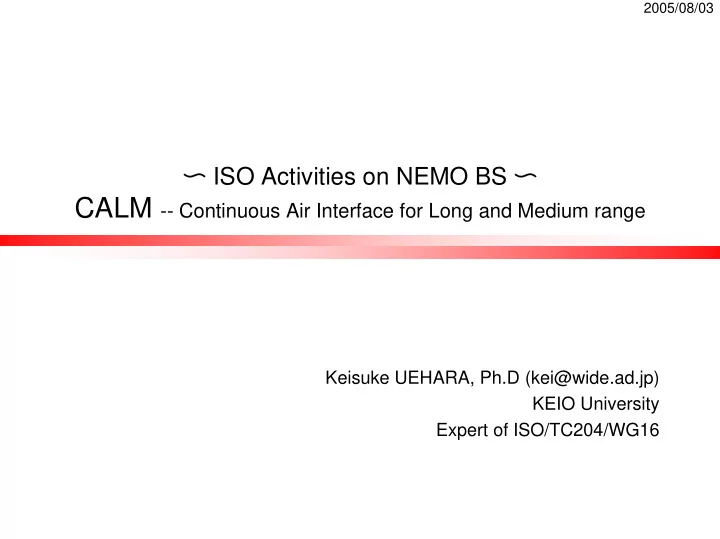

2005/08/03 ~ ISO Activities on NEMO BS ~ CALM -- Continuous Air Interface for Long and Medium range Keisuke UEHARA, Ph.D (kei@wide.ad.jp) KEIO University Expert of ISO/TC204/WG16
Purpose of this presentation Inform the IETF NEMO WG about the use of NEMO BS in the CALM standard for Intelligent Transportation Systems defined by ISO TC204 WG16 ISO/TC204/WG16 accepted to use NEMO in their standard. Input their problem to the NEMO WG MR-MNN protocol is necessary. 2
ISO/TC204/WG16 and CALM Role of ISO/TC204/WG16 is to make the standard for ITS wide area communication. http://www.tc204wg16.de/ CALM is communication architecture of ITS wide are communication. must support both of ITS services (Electric Toll Collection, Fleet management, etc.) and Internet services needs to support continuous communications with user transparent networking and handover spanning multiple media, media providers ⇒ Adoption of MIP6/NEMO Sub-working groups are working on CALM. SWG16.0 Architecture SWG16.1 Individual communication media for ITS SWG16.2 Network Layer 3
CALM Application examples Low-latency applications Emergency indication Electric Toll Collection Electric Fee Payment Traffic information shower under a gate ITS applications Traffic information distribution MAP distribution / remote update Fleet management Probe Car system Dynamic route guidance Internet applications Music distribution, Mail, Web, VoIP… 4
CALM Scenarios Scenario 0 (out of focus) Scenario 1 (without the Internet access) • Single media • Single media • Running car • Running car Server Server Not IP IPv6 Scenario 2 (without Media switching) Scenario 3 (with Media switching) • Internet access using single media • Internet access using multiple media • Running car with wide area communication media • Supports both of running car and parking car • Parking car • Full bi-directional communication support • Car requests to server Server Server with MIP6/NEMO (Only car can initiate communication) Internet Internet Internet Internet without MIP6/NEMO IPv6 IPv6 5
Three Physical configuration in Scenario 3 MIP6 NEMO In-vehicle Router (MR) In-vehicle Computer (MN) In-vehicle computer Model-1: Single Computer model Model-2: Single Router model NEMO with Multiple MR In-vehicle In-vehicle Router (MR) Router (MR) In-vehicle computer Model-3: Multiple Routers model 6
CALM Architecture and SAPs of Network part 2G: 2 nd Generation Cellular Phone CME: CALM Management Entity 3G: 3 rd Generation Cellular Phone Match making application policy and Network status IR: Infrared NEM: Network Management Entity M5: 5GHz Band ITS Media - Signal to CME the Network status MM: Microwave Media - Control MIP6/NEMO status PPM: Point to Point Millimeter wave IME: Interface Management Entity WBB: Wireless Broadband - Signal to NME the media status IVN: In-Vehicle Network SAP SAP defined in ISO21210 SAP defined outside of ISO21210 SAP Application Application Application CME With Internet Access With Internet Access SAP without Internet Access (ISO21210) Without Media switching With Media switching SAP TCP/UDP NME SAP (ISO21210) IPv6 Routing & Media switching (ISO21210) SAP SAP SAP Lower SAP (ISO21218) IME 2G 3G IR M5 MM MAIL WBB IVN (ISO21218) (ISO21212) (ISO21213) (ISO21214) (ISO21215) (ISO21216) (TBD) (TBD) (TBD) 7
Why do we need CME and NME? Motivation for interface selection from the MNN Assumptions MR and MNN (ex. Car Navigation System) will be delivered by different organization (company). Configuration will be change dynamically. New communication media are available year by year. User brings his/her laptop computer into a vehicle. Only MNN has user interfaces, runs applications. Consideration “3” means that MNN must be able to do one of followings: Interface switching policy setting Interface selection “3” means that signaling protocol between MR and MNN is necessary. For examples: MR->MNN: New Interface available. MR->MNN: Interface has been switched. MNN->MR: Which interface is most preferable. “2” means that MNN-MR protocol must support dynamic discovery “1” means that “Standard” is necessary. 8
Problems Multiple MR Single MR Model MS Model SS-1 Model SS-2 Single MNN CME-NME Discovery MN MNN CME-NME MNN NME-NME Discovery MR MR MR Model SM Model MM Multiple MNN CME-NME Discovery CME-NME Discovery CME-CME CME-CME MNN MNN MNN MNN NME-NME MR MR MR 9
Schedule Apr. 2001 Proposed PWI with other CALM Media Start to consider the requirements Apr. 2004 NP ballot. Approved. Oct. 2004 First version of Working Draft was published Feb. 2005 Decided to split to two documents, 21210-1 (Internet connectivity) and 21210-2 (Vehicle to Vehicle) End of 2005 CD ballot of 21210-1. PWI = Preliminary work item NP = New work item Proposal CD = Committee draft DIS = Draft International Standard FDIS = Final Draft International Standard IS = International Standard 10
11 Thanks. High level requirements
Recommend
More recommend